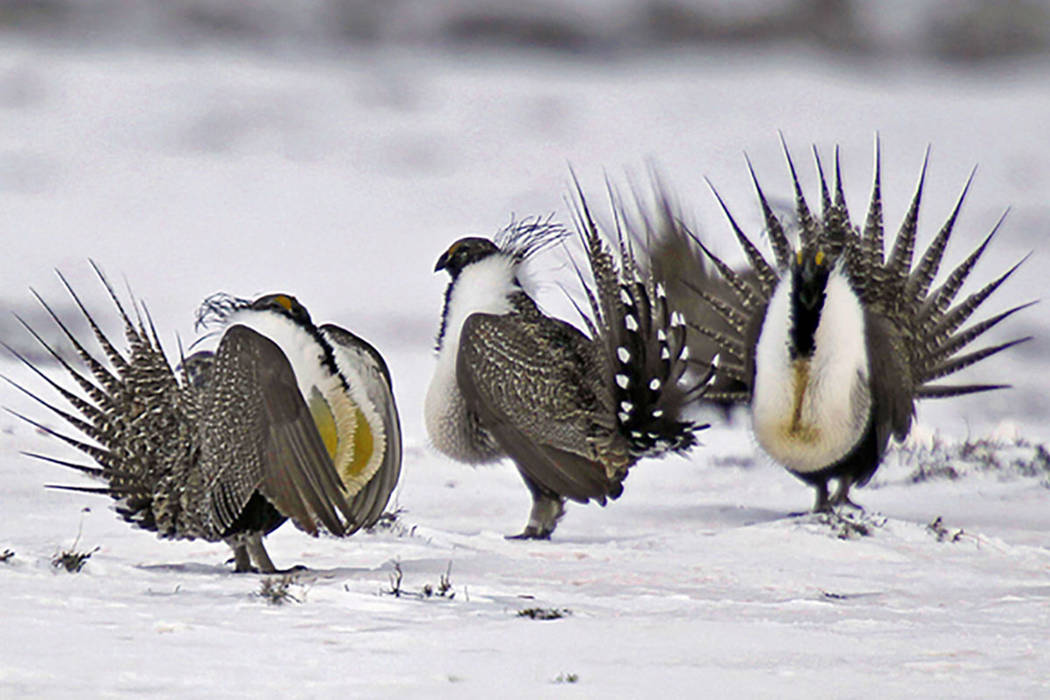BLM to release plan for protecting sage grouse habitat
WASHINGTON — The Bureau of Land Management will release its final plan for protecting the habitat of the greater sage grouse in Nevada and six other Western states on Friday — a plan that has the support of Nevada Gov. Steve Sisolak.
Acting Interior Secretary David Bernhardt hailed the plan as the product of “months of close coordination and cooperation with state governments in Wyoming, Nevada, California, Idaho, Oregon, Utah and Colorado.”
In a statement provided by the Interior Department, Sisolak thanked BLM for working cooperatively “with state agencies and local stakeholders.”
The ground-nesting bird, said to have reached a population of 16 million at its height, once served as a staple in Native American diets and was later dubbed “sage chickens” by pioneers, according to the Nevada Greater Sage-Grouse Conservation Plan. But then modern practices and development shrank the population to a half million or less.
In 2010, the U.S. Fish and Wildlife Service determined the greater sage grouse was threatened or endangered. In 2015, the Obama administration enacted a sweeping sage grouse conservation plan that was met with opposition from a number of governors, including then Nevada Gov. Brian Sandoval, a Republican.
President Donald Trump brought a new approach. Former Trump Interior Secretary Ryan Zinke determined to relax the Obama regulations and work with states to allow more flexibility in land use, but still protect the chicken-sized bird without hindering economic development.
“One size doesn’t necessarily fit all,” said Brian Steed, deputy director of the BLM, adding that sage grouse in one state have different needs than sage grouse in other states.
The plan for Nevada, which also covers a portion of northeastern California, can focus on fire prevention and target non-native grasses that helped fuel last year’s massive fires.
Fire, Steed said, is the “biggest threat to birds in the Great Basin.”
Michael Saul of the Center for Biological Diversity, which opposes the new sage grouse plan, agrees that fire is a big threat, but said, “It’s not clear to me what they’re doing that would actually help with fire mitigation.”
In a statement, Sisolak, a Democrat, said that Nevada “appreciates the BLM’s commitment to compensatory mitigation as an integral part of the success of Nevada’s habitat management plan.”
The Nevada Conservation Credit System is a mechanism that provides financial disincentives for the destruction of sage grouse habitat and offers credits for habitat conservation.
“The problem is humans really don’t know how to make new functional sagebrush habitat or even in most cases restore degraded sagebrush habitat,” Saul added, “or somehow persuade sage grouse to become loyal to it.”
Kelly McGowan of the state Sagebrush Ecosystem Program agreed that it can be challenging to get sage grouse to move, but “as habitat burns, as it recovers, leks have come and gone off the landscape.” Leks are sage grouse mating areas.
While Sisolak praised the Interior plan’s “compensatory mitigation” as helpful to Nevada, Kelly McGowan of the state Sagebrush Ecosystem Program said the Nevada Conservation Credit System has never received funds from the federal government.
While the plan’s details will not be released until Friday, Saul said, “All of the changes that are proposed are being moved in one direction, to increase certainty for oil and gas operators, hard-rock mining operators, in some places, public lands livestock grazing and to decrease certainty that intact functional sage grouse habitat is going to be protected.”
Contact Debra J. Saunders at dsaunders@reviewjournal.com or 202-662-7391. Follow @DebraJSaunders on Twitter.
Want to see for yourself?
It's a trek and you have to wait until April 21, but the Northeastern Nevada Stewardship Club hosts the Sage-Grouse Experience.























